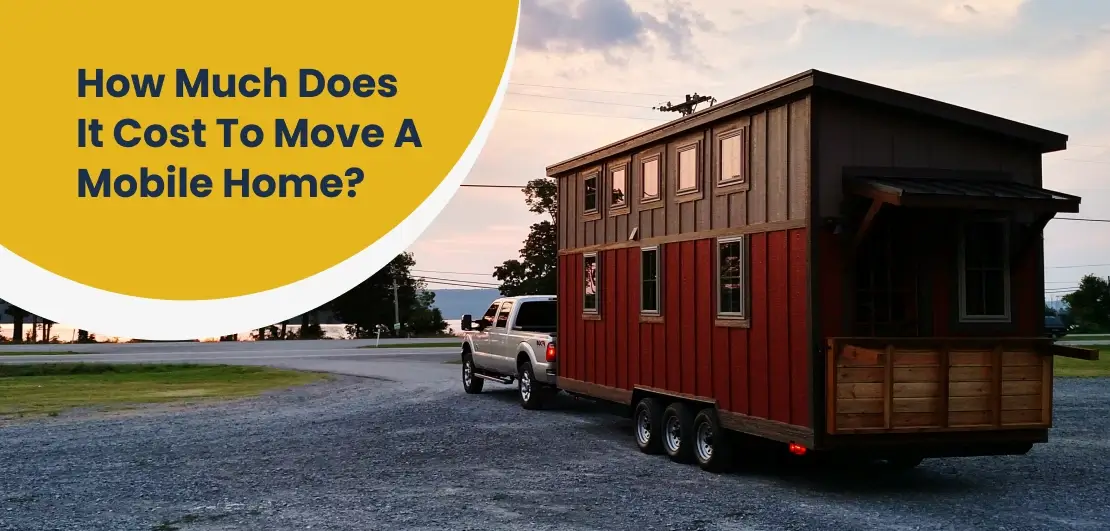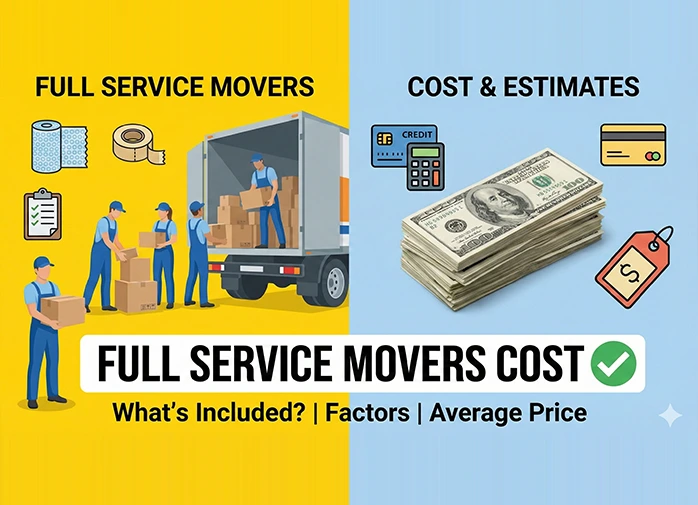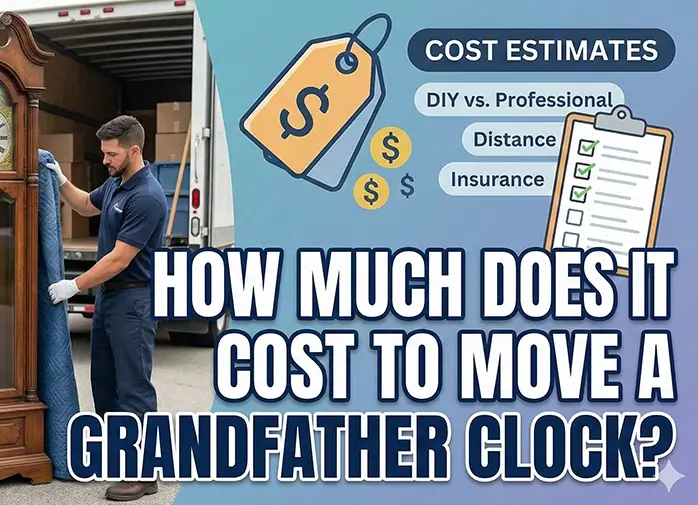How Much Does It Cost to Move a Mobile Home?

Moving a mobile home is no small task. Beyond packing your belongings, you need to factor in permits, specialized trucks, escort vehicles, and site preparation. In 2025, mobile home moving costs have risen due to inflation, fuel prices, and state-level permit requirements. Whether you’re relocating across town or across states, understanding the cost structure is crucial for budgeting. Lets discuss about how much does it cost to move a mobile home.
Cost Range Overview
- Normal Range (U.S.): $5,000 – $13,000
- Average Cost: Around $8,500
- Low-End Estimate: $3,000 (short-distance, single-wide, minimal permits)
- High-End Estimate: $20,000+ (long-distance, double-wide, complex site prep)
- Why the Variation? Costs depend on distance, size, permits, site preparation, and whether professional movers or DIY methods are used.
How Much Does It Cost to Move a Mobile Home: Costing Breakdown
Normal Range for the U.S.
Most homeowners pay between $5,000–$13,000 for a complete move, including disassembly, transport, permits, and reinstallation.
Average Cost
In 2025, the average is $8,500, factoring in inflation and higher fuel prices compared to 2024.
Low-End & High-End Estimates
- Low-End: $3,000 – A short-distance move for a single-wide with no setup.
- High-End: $20,000+ – Long-distance double-wide with escort vehicles, foundation prep, and new hookups.
How We Get This Data
Estimates are based on industry reports, mover quotes, and updated state DOT (Department of Transportation) permit fees for 2025.
Key Factors That Affect Mobile Home Moving Costs
When calculating the cost of moving a mobile home, it’s not just about mileage. Several key factors directly influence the total price you’ll pay. Let’s break them down in detail:
1. Size and Weight of the Mobile Home
One of the biggest cost drivers is the size and weight of your mobile home.
- Single-wide homes: Typically range from 600–1,200 square feet and are easier and cheaper to move because they can usually be transported in one piece. Moving a single-wide often requires just one truck and fewer permits, lowering the total cost.
- Double-wide homes: These average 1,500–2,500 square feet and must be split into two or more sections before transport. That means extra labor, specialized equipment, and multiple trucks are required. The reassembly process at the new site also adds costs for leveling, sealing, and reconnecting utilities.
Cost Impact: Expect single-wide moves to fall on the lower end of the cost range, while double-wide homes often double or even triple moving expenses.
2. Distance of the Move
The length of your move plays a critical role:
- Local moves (under 50 miles): These are usually the most affordable since fuel and driver labor are minimal. Many movers offer flat-rate pricing for short distances.
- Long-distance moves: Once you cross state lines or move hundreds of miles, the price rises steeply. Longer trips add costs for fuel, overnight lodging for drivers, tolls, and extra logistics such as road clearances or special permits across multiple states.
Cost Impact: A short move might cost $1,000–$3,000, but a cross-country relocation can exceed $15,000, depending on home size.
3. Type of Transport
Not all mobile homes travel the same way:
- Single-wide transport: Typically requires one trailer truck, which is relatively straightforward. This keeps costs lower, especially for local moves.
- Double-wide transport: Requires two trucks, and in many cases, escort vehicles (pilot cars) to ensure safety on highways. Double-wide moves also face higher permit fees since they exceed standard highway width limits.
Cost Impact: Transporting a double-wide can cost 30–50% more than moving a single-wide.
4. Disassembly and Reassembly
Mobile homes aren’t just picked up and dropped off—they often need partial dismantling before transport.
- Disassembly tasks: This may include removing skirting, decks, porches, awnings, sheds, or HVAC systems. Each of these steps adds labor time and cost.
- Reassembly at new site: Once the home arrives, it must be leveled, sections reattached, utilities reconnected, and features like porches or skirting reinstalled. Skilled labor is required, and the costs can vary depending on the complexity of the setup.
Cost Impact: Disassembly and reassembly can add $1,000–$5,000 or more on top of transportation fees.
5. Permits and Escort Vehicles
Mobile homes are considered oversized loads, which means you can’t just drive them down the highway without approval.
- Permits: Each state has its own requirements for wide-load permits. Fees usually range from $100 to $500 per state. If your move crosses multiple states, you’ll need permits for each one.
- Escort vehicles: Double-wide or oversized mobile homes often require one or more escort vehicles (pilot cars) to travel in front of and behind the load. Each escort can add $200–$500 to the cost, depending on distance.
Cost Impact: For long-distance moves, permits and escorts can add thousands of dollars to your total bill.
6. Route and Road Conditions
Not all roads are suitable for transporting mobile homes. Movers must carefully plan the route, considering:
- Highway restrictions: Certain highways restrict oversized loads or require specific travel times.
- Bridge clearances: Low bridges or narrow roads can make transport difficult, sometimes requiring alternate (longer) routes.
- Tolls and road fees: These add to the overall expense.
- Rural access roads: If your destination is in a remote area with unpaved or narrow roads, movers may need special equipment to navigate, which raises costs.
Cost Impact: Complicated routes can add hundreds to thousands of dollars in detours, tolls, and time.
Additional Costs to Consider
- Permitting Requirements by State – Range from $150–$1,000+ depending on state DOT rules.
- Hookup and Utility Disconnection/Connection – $500–$2,500 for plumbing, electricity, and HVAC.
- Foundation Preparation at New Site – $1,000–$5,000 depending on soil and structure.
- Insurance and Liability Coverage – Movers require insurance; coverage can cost $300–$800.
- Seasonal Pricing Variations – Summer moves are more expensive due to demand.
- Tipping Movers (Optional) – $20–$50 per crew member.
Cost of Moving a Mobile Home Yourself
Is It Legal to DIY Move a Mobile Home?
In most states, you cannot legally transport a mobile home yourself unless you have a special permit and a CDL (Commercial Driver’s License).
Truck and Equipment Rental
Heavy-duty trucks and trailers cost $1,500–$3,000/day, plus fuel.
Tools and Safety Gear
Hydraulic jacks, winches, tie-downs, and safety flags add costs.
Time, Risk, and Licensing Requirements
DIY attempts often result in fines, damage, or legal issues. Most experts strongly discourage DIY mobile home moves.
DIY vs Hiring a Professional
Pros and Cons of DIY Move
- Pros: Lower upfront costs, control over schedule.
- Cons: Legal restrictions, safety risks, lack of insurance.
When to Hire a Licensed Mobile Home Mover
- State laws often require movers to be licensed and insured.
- Professionals handle permits, escorts, and reassembly.
State Requirements for Transport Licensing
Each state has its own DOT rules—some require police escorts for wide-load mobile homes.
How to Save Money When Moving a Mobile Home
Moving a mobile home is a significant financial commitment, but with careful planning, you can cut down costs without sacrificing safety or quality. Below are proven strategies to save money during the process:
1. Downsize Furniture and Belongings
The cost of moving a mobile home is influenced not only by the structure itself but also by what’s inside. The more items you transport, the higher the fuel and labor charges. By reducing the load, you can save considerably.
- Declutter before moving: Sell, donate, or recycle items you no longer need. Heavy furniture, outdated appliances, or bulky décor may not be worth the cost of transport.
- Store vs. move: If you’re relocating temporarily, consider using a local storage unit instead of transporting everything at once.
- Weight matters: Less weight reduces fuel consumption and makes it easier for the moving crew to load, transport, and reassemble your home efficiently.
Tip: Host a garage sale or list items online before the move—you can offset moving expenses with the extra cash.
2. Book Off-Season Moving Dates
Just like traditional household moves, mobile home relocation has peak and off-peak seasons. Summer and early spring are the busiest, which drives prices up.
- Best time to move: Late fall and winter (October through February) typically offer lower rates since demand is lower. Movers are more available, and you may even negotiate discounts.
- Mid-month, mid-week advantage: Moving companies tend to charge less during weekdays or mid-month since weekends and month-ends are high-demand slots.
- Avoid holidays: Moving around major holidays often comes with premium surcharges due to limited staffing.
Tip: If your timeline is flexible, ask movers about discounted off-season or “gap” dates when they’re returning from another job.
3. Get Multiple Quotes
The price of moving a mobile home can vary dramatically from one company to another. Shopping around ensures you don’t overpay.
- Request at least three estimates: Compare licensed and insured movers who specialize in mobile home transport.
- Ask for itemized breakdowns: Understanding what’s included—permits, escort vehicles, utility hookups, etc.—prevents hidden fees.
- Check credentials: The cheapest quote isn’t always the best. Make sure the mover is certified and complies with state transport regulations.
Tip: Use quotes as leverage—if one company offers a lower rate for permits or escorts, ask competitors to match it.
4. Prepare the Site in Advance
Preparation can make or break your budget. Movers often charge extra if they have to do tasks that homeowners could have handled beforehand.
- Clear the lot: Remove debris, vehicles, or landscaping obstacles that could slow down the moving crew.
- Foundation readiness: Have the new site leveled and the foundation prepared ahead of time. If movers must wait or perform site prep, it adds hours of labor costs.
- Utility management: Disconnect water, electricity, and sewer lines before moving day. Some companies charge additional fees for this step.
Tip: Hire local contractors for groundwork and utility prep—it’s usually cheaper than having the mobile home mover handle everything.
Conclusion
Moving a mobile home in 2025 is a major undertaking, both logistically and financially. On average, expect to spend $8,500 for a professional move, though costs can range from $3,000 to over $20,000 depending on size, distance, and permits. While DIY may seem tempting, legal and safety issues make professional movers the smarter choice. By planning ahead, comparing quotes, and preparing your new site, you can relocate your mobile home smoothly while keeping costs under control.
Frequently Asked Questions
1. Can you move a double-wide mobile home?
Yes, but it must be split into two sections. Costs range from $10,000–$20,000+.
2. Do you need a permit to move a mobile home?
Yes, every state requires permits for oversized loads.
3. How far can you move a mobile home?
There’s no legal distance limit, but longer moves increase costs significantly.
4. What is the cost difference between local and long-distance moves?
Local: $3,000–$8,000.
Long-distance: $10,000–$20,000+.
Categories
- Long Distance Moving154
- Local Moving120
- Commercial Moving40
- Residential Moving34
- Last – Minute Moving25
- Moving Tips & Lifestyle10
- Furniture Moving9
- Moving Tips & How-To Guides8
- Moving services7
- Moving Cost5
- Moving Cost Calculator5
- Moving Costs & Budgeting5
- moving tips4
- state to state movers4
- Piano Moving3
- Car Transportation3
- Truck Rental3
- Local Move3
- Moving companies3
- best moving rates3
- cheap moving companies3
- affordable moving companies3
- full-service movers3
- Moving Cost Guides3
- Junk Removal2
- Moving Container2
- Senior Moving2
- Senior Relocation Moving Companies2
- Moving Tools2
- Moving Estimates2
- interstate moving2
- College Moving2
- Moving2
- Dorm Moving2
- cross-country move2
- International moving2
- Household moving2
- Relocation Guide2
- Moving Tips & State Guides2
- Moving Tips & Planning2
- Heavy Equipment1
- Senior Moving Services1
- office moving1
- office relocation1
- employee relocation1
- Car Transport1
- Vehicle Shipping1
- Car Shipping Services1
- Artificial Intelligence1
- Office Moving Services1
- Commercial Moving Companies1
- Corporate Moving Services1
- Corporate Movers1
- full-service moving companies1
- sustainable moving companies1
- green movers1
- Moving in US1
- Best places to move in 20251
- 2025 moving1
- Full-Service Moving Companies1
- College moving services1
- Moving to College1
- Tips for moving1
- donate1
- sell1
- Movers in California1
- Movers in Studio City1
- Moving to California1
- Laws about Moving into California1
- Moving Laws1
- House moving1
- packing1
- cheap moving ways1
- Moving guide1
- moving across countries1
- international relocation program1
- move out cleaning1
- right packing supplies1
- pack while moving1
- Apartment moving1
- PODS1
- moving out1
- state to state move1
- California movers1
- Truck Rental1
- US Territory Relocation1
- International Moving1
- Shipping & Moving Tips1
- Moving Tips1
- Moving Budget Guide1
- Relocation Guides & Incentives1
- Moving Tools & Equipment Guides1
- Moving Services & Options1
- Moving Tips & How-To Guides1
- Moving Day & Settling In1
- Mobile Home Moving1
- Moving Guide & Tips1
- Moving Tips & State Comparisons1
- Moving Tips & City Guides1
- Moving Tips & Cost Guides1
- Long-Distance Moving Tips1
- Moving Tips & Financial Planning1
- Moving Tips & Home Preparation1
- Vehicle Shipping & Auto Transport1
- Marketing & Lead Generation1
- International Moving Guides1
- Moving Costs1
- San Francisco Moving Guide1
- NYC Moving1
- Local Movers1
- Budget Moving1
- Student Moving1
- Affordable Moving1
- Specialty Moving Guides1
- Local & Long-Distance Moving1
- Boston Moving Guide1
- Europe Relocation Guide1
- Moving Costs & Specialty Moving1
- Cost of Living1
- Relocation1
- International Moving1
- Moving Guides1
- Lifestyle & Relocation1
- State Guides1
Archives
Recent posts
-

25 Interesting Facts About Florida You Probably Didn’t Know
January 2026 -

How Much Do Full-Service Movers Cost? A Complete Moving Cost Breakdown
January 2026 -

How Much Does It Cost to Live in Ireland? A Complete Cost of Living Guide
December 2025 -

How Much Does It Cost to Move a Grandfather Clock?
December 2025

 Local Movers
Local Movers Last-Minute Movers
Last-Minute Movers Junk Removal
Junk Removal Long Distance Movers
Long Distance Movers Piano Movers
Piano Movers Heavy Equipment
Heavy Equipment Commercial Movers
Commercial Movers Moving Container
Moving Container Car Transportation
Car Transportation Furniture Movers
Furniture Movers Truck Rental
Truck Rental Moving Cost Calculator
Moving Cost Calculator Moving Planner
Moving Planner Packing Calculator
Packing Calculator Moving Checklist
Moving Checklist Moving Insurance
Moving Insurance FAQ
FAQ Contact Us
Contact Us Moving Loan
Moving Loan About Us
About Us







